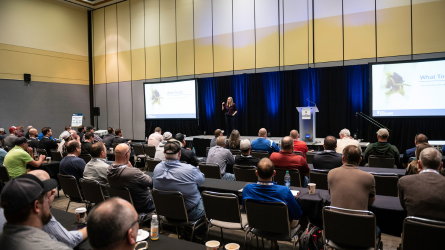Retention is Your Best Recruitment Strategy

It’s no secret, the labor pool is shallow, and the water is murky. Still, work needs to get done.
According to a study by the Job Openings and Labor Turnover Survey (JOLTS), as many as 4.5 million Americans quit their job every month. A single resignation has been shown to cost a company $11,372. Turnover is up about 20 percent. One third of all new hires quit in the first six months.
In the state of Kansas alone, there are 23,843 unfilled ag and ag-related positions.
These facts, and more, had attendees at GEAPS Exchange getting up early to attend a Monday morning session on employee retention.
Dr. Danielle Crough presented “Retention is Your Best Recruitment Strategy.” So many people flocked to her session extra chairs had to be brought in and people even sat in the dreaded front row. Her session used comedy and straight talk to discuss the value of retention and how every person in our industry—no matter their company or role in that company-can work to hold on to their people.
As Vice President of People and Culture at Interstates, it is Crough’s day job to find—and retain—quality employees. It’s a big job that requires a lot of resources that’s never done. There are more than 100 open positions listed on their website, but Interstates enjoys a high level of retention.
Crough has been there for eight years. She recently attended retirement parties for colleagues who had been at Interstates for three or four decades.
Crough said she has found tremendous value in working to retain employees. She took some time to meet with us before GEAPS Exchange to discuss this important topic.
“When talent is hard to find and we have an overall talent shortage, especially in the industries that encompass GEAPS, we can get hyper focused on recruitment and spend a lot of money and resources there. However, if you actually spend more resources on retention, it ends up positively impacting recruitment,” Crough said.
Being flexible with employees is about more than offering remote work, especially in fields where remote work isn’t possible.
“You can provide flexibility in other ways. Whether that be in schedule or work opportunities,” Crough said.
That might mean adjusting a schedule. An employee not a morning person? Let them start their day later. You just might benefit by having someone still working past the traditional ‘quitting time.’ Busy season at work but someone’s child has a school program?
Make it possible for them to attend.
While it may not seem intuitive, it works.
“If you do right by the people that are currently at your organization, they are your best ambassadors; they are your best recruiters,” Crough said. “They end up doing the work for you. No matter how much technology we have and all the different ways you can apply for jobs, your network is still the best way to find out about what the experience is like. If you’re creating an experience that’s worth talking about—negatively or positively—then people are hearing about it.”
Being flexible with employees is about more than offering remote work, especially in fields where remote work isn’t possible.
“You can provide flexibility in other ways. Whether that be in schedule or work opportunities,” Crough said.
That might mean adjusting a schedule. An employee not a morning person? Let them start their day later. You just might benefit by having someone still working past the traditional ‘quitting time.’ Busy season at work but someone’s child has a school program?
Make it possible for them to attend.
Interstates’ positive reputation for investing in people and providing opportunities is what attracted Crough to her position. It’s what can attract prospective employees to your company as well.
By focusing on retention, Crough said, you won’t need to spend as much time or money on recruitment.
“You have to make sure you are creating an environment where people feel included no matter what. We continue to have, not only changing demographics but just people who have different needs, and are looking for different things at work. No matter what that is, you have to make sure you’re creating an environment where everyone feels like they’re included and they belong. That’s critical for retention and engagement,” Crough said.
Is recruitment and retention an issue where you work? Register for this GEAPS webinar where Danielle Crough will expand on this topic. Join us at 11 a.m. Central, Wednesday June 5.
Contact:

Jessica Waltzer
Communications Manager
Jessica@geaps.com
763-999-4306


